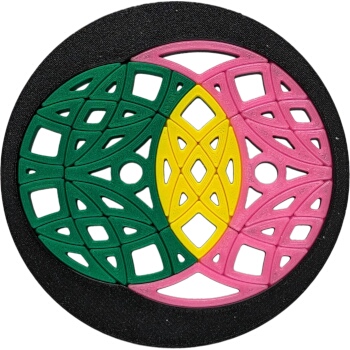





Two intersecting circles turning in steps of 120° and 180°.
- Inventor : Dmitry Andreev
- Mechanism : Intersecting circles
- Patents : Unknown
- Producer : Customly 3D printed
- Year : 2024
- Original Price : Unknown USD
- Average Price : Unknown USD
Alpha Delphini (α Delphini, abbreviated Alpha Del, α Del) is a multiple star system in the constellation of Delphinus.
The system bore an historical name, Sualocin, which arose as follows: Niccolò Cacciatore was the assistant to Giuseppe Piazzi, and later his successor as Director of the Palermo Observatory. The name first appeared in Piazzi's Palermo Star Catalogue. When the Catalogue was published in 1814, the unfamiliar names Sualocin and Rotanev were attached to Alpha and Beta Delphini, respectively. Eventually the Reverend Thomas Webb, a British astronomer, puzzled out the explanation. Cacciatore's name, Nicholas Hunter in English translation, would be Latinized to Nicolaus Venator. Reversing the letters of this construction produces the two star names. They have endured, the result of Cacciatore's little practical joke of naming the two stars after himself.
Alpha Delphini A is a spectroscopic binary star which has now been resolved using speckle interferometry. The components are separated by 0.2″ and have a 17-year orbit. Alpha Delphini Aa has a spectral type of B9IV. it is a subgiant that has begun to evolve away from the main sequence, is about 3.8 times as massive as the sun and about twice as hot.
The spectral type of the secondary star cannot be determined as it is too close and too faint compared to the primary, but it has been shown to itself be a binary star with an orbit of 30 days. Spectral lines showing 30-day radial velocity changes are likely to belong to the faintest component, expected from its mass to be an F-type star. Then the more massive star of the inner pair is likely to be an A-type dwarf, possibly not detected in the spectral because rapid rotation blurs its absorption lines.
The closest relatives to this puzzle are Darubutorio and Trilotica V4. In Sualocin the circles are closer to each other which increases the piece count heavily.
Found a mistake or something missing? Edit it yourself or contact the moderator
- Members: 5182
- Most recent: r_primer
- Members online: and 1 hidden, as well as 8 guests and 1 web crawlers.
- Topics/posts: 37751/416564
- Some recent posts:
- Re: Stickerless Spherical Kilominx by Jared an hour ago.
- Re: Stickerless Spherical Kilominx by Manqube 2 hours ago.
- Re: Stickerless Spherical Kilominx by Manqube 2 hours ago.
- "Five past Eight" by KK Puzzles by djpibody 8 hours ago.
- Re: Parasitic & Symbiotic Corner Pocket by ecuber 9 hours ago.
- Thanks for spending your time with us
Frank
and Darren.
You are missed.